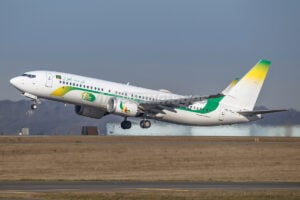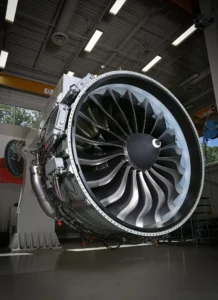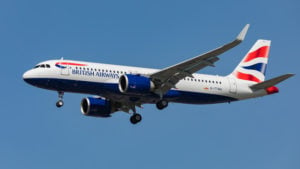Exploring the most cost-effective ways of providing access to sufficient spare engines
Effective spare engine coverage is essential for the smooth operation of any airline, but it comes at a cost. For example, the list price for a new Pratt & Whitney jet engine, such as the PW1100G for the Airbus A320neo, is typically around US$12 to US$15 million, while the list price for a new GE jet engine can range from US$14.5 million to US$42 million, depending on the specific engine model and its intended application. For example, the GE9X engine, intended for the Boeing 777X, has a list price of US$42 million. The LEAP-1A and LEAP-1B engines, used in Airbus and Boeing aircraft respectively, have a list price of US$14.5 million each. For those operators with large fleets, the number of spare engines required can tie up massive sums of money, thus leading to exploring pooling or leasing of engines as financially more viable options. We spoke to four MRO specialists on the topic of adequate spare engine coverage to get their opinion on the many challenges faced.
Why spare engine coverage is critical for airline reliability and operations
One has to accept that aircraft engines require long lead times for repair or replacement and while engine reliability is very high, there are occasions when engines suffer unscheduled removals. Even properly performing engines are scheduled for removal, based on pre-planned performance deterioration and life-limited parts expiration. Therefore, spare engine coverage is critical for airline reliability and operations, ensuring minimal disruption in the event of an engine failure or maintenance requirement. As John McCarthy, Director Business Development Europe, VAS Aero Services further explains, “An active spare engine programme allows airlines to quickly replace unserviceable engines and maintain schedules, thereby mitigating the risk an operator faces of prolonged AOG situations, flight delays, cancellations, and increased operational costs. Having a spare engine available reduces the financial impact of unplanned downtime and supports continuous service. Ultimately, it enhances an airline’s resilience and operational continuity.”
At AERO CARE, Managing Director Anca Mihalache sees spare engines as an unavoidable necessity, commenting that: “Depending on the size of the airline, having one or more spare engines is essential for smooth operations. In most cases, serious on-wing engine repairs aren’t possible, therefore, if an issue occurs, the engine needs to be replaced immediately. Having a spare engine available at base allows the airline to avoid extended aircraft downtime and reduces operational costs.” Meanwhile, at AMROS Global, Oliver Boro, CAMO Technical Consultant Engines, sees flexibility as a key component when it comes to unscheduled engine removals. “Spare engine coverage is critical for airline reliability and operations because spare engines ensure aircraft remain airworthy even when standard engines are undergoing maintenance or are out of service. Spare engines provide flexibility in managing scheduled and unscheduled removals, preventing ground time and maintaining high levels of aircraft dispatch reliability,” he advises.
Spare engine coverage is vital for maintaining continuous, reliable operations in commercial aviation as engines are routinely removed for scheduled maintenance—whether for periodic inspections, overhauls, or component replacements—and these planned removals occur much more often than unscheduled failures. Without a ready spare, even a scheduled removal can leave an aircraft grounded, disrupting the overall schedule and potentially impacting network connectivity. Virgil D. Pizer, Chief Executive Officer, Pem-Air Turbine Engine Services expands further: “Having a robust spare engine programme allows airlines to quickly swap out engines during routine maintenance without compromising the fleet’s availability. This not only minimises aircraft downtime but also helps ensure that all engines meet strict regulatory standards and OEM maintenance requirements, keeping the fleet operating safely and efficiently. For smaller operators, with leaner fleets, the importance of spare engine coverage is even greater. With fewer aircraft, each engine loss—whether for planned or unplanned reasons—has a larger impact on overall operations. These operators must carefully balance the costs of holding spares with the risk of operational disruptions. In such cases, proactive planning, close coordination with MRO partners, and possibly exploring collaborative pooling arrangements become essential to manage both scheduled maintenance needs and unexpected events effectively. In short, spare engine coverage is not merely an inventory upfront—it’s a strategic safeguard that enables smooth, uninterrupted flight operations by aligning maintenance schedules with immediate engine availability, ensuring continuous compliance and operational resilience.”
How to effectively forecast the need for spare aircraft engines for a fleet over time
Ultimately, forecasting spare engine needs effectively is a multi-faceted process that blends historical performance analysis with real‑time data and statistical modelling. At its core, operators review past engine performance—tracking engine flight hours, cycles, and failure rates—to understand typical maintenance events and predict when an engine is due for overhaul or scheduled removals as dictated by OEM guidelines and life-limited part (LLP) schedules. Crucially, this forecasting isn’t limited to planned or scheduled maintenance events. It must also account for unscheduled engine removals resulting from unexpected failures or anomalies. These unplanned events introduce an element of unpredictability and require additional safety buffers to ensure that spare engines are available when needed. By combining predictive maintenance technologies, such as sensor-based monitoring, with robust statistical models, operators can better estimate not only routine maintenance cycles but also the likelihood and impact of unforeseen events on spare inventory requirements. Virgil D. Pizer goes on to explain that the above comprehensive approach ensures that “spare engine coverage is aligned with both predictable and unexpected engine removals, allowing airlines to minimise operational disruptions while maintaining high safety and reliability standards.” He continues:
“For smaller operators, unique challenges arise in this forecasting process:
• Data Limitations: With fewer engines in service, statistical models may be less robust, making it harder to predict failure rates and maintenance cycles with high confidence. Variability in engine usage or unexpected issues can have a larger impact on forecast accuracy.
• Economies of Scale: Smaller fleets often face higher per-engine costs for maintaining spares. The investment in advanced predictive analytics or condition-monitoring systems may represent a disproportionately large expenditure relative to the fleet, complicating efforts to optimise spare coverage.
• Logistical and MRO Dependencies: Limited in-house maintenance capabilities often mean that smaller operators must rely on third-party MRO providers. This can create timing and availability challenges, as spare engine forecasting must account not only for technical needs but also for potential delays in repair and replacement from external sources.
• Financial and Contractual Constraints: With reduced negotiating power compared to larger carriers, smaller operators may have less favourable terms for spare engine supply and maintenance contracts. This further complicates the ability to balance forecasted needs with budgetary and operational realities.
In summary, while all operators use a combination of historical analysis, OEM guidelines, and real-time data to forecast engine spares, smaller fleets face amplified uncertainties and higher per-unit costs. These challenges necessitate a more agile and collaborative approach—such as pooling resources or leveraging integrated service agreements—to ensure that spare engine coverage remains robust and effective over time.”
Oliver Boro provides us with a concise response, advising that: “Forecasting spare engine needs involves predicting the number of engines required to maintain operational readiness and minimise downtime. This is typically done by considering factors like fleet size, engine type, utilisation rates, spare engine ready when one fails, scheduled shop visits and turnaround time,” while John McCarthy goes into greater detail, with an emphasis on data analysis. He explains: “Effective forecasting involves analysing a combination of operational data, maintenance schedules, and engine performance trends. Predictive maintenance tools and historical data are employed to anticipate engine removals due to wear, scheduled overhauls, or unexpected failures. Key factors in this analysis include fleet size, engine type, flight hours, cycles, and operational environments. By modelling these variables, operators can better predict when and how often engines replacements will be needed, and this leads to planning for spare engine acquisition, leasing, or pooling. Additionally, maintenance intervals, shop visit turnaround times, and logistics considerations should be factored in to ensure spare engines are positioned where and when they’re most likely needed. Effective forecasting minimises aircraft-on-ground (AOG) risks, supports uninterrupted flight schedules, and optimises spare engine inventory investment.”
How engine maintenance schedules influence the planning of spare engines
Here, Anca Mihalache sees an overall limit on engine availability as greatly affecting engine coverage options. She tells us that: “Even hospital shop visits can now take twice as long as they did in the pre-COVID era. There is a shortage of experienced repair specialists, and Broward Aviation Services [who Mihalache also advises] knows that spare parts are also harder to source. In the past, some MROs would offer a lease engine during the shop visit (some still do), or green-time and short-term lessors would step in. But with engine availability so limited today, even planned maintenance events can pose significant risk. Having one or more spare engines helps protect the airline’s schedule.” However, Oliver Boro sees things through a simpler lens as he explains: “Maintenance schedules are affecting effective spare engine coverage planning, as they directly influence the likelihood of future maintenance needs. By understanding the planned maintenance activities and their timing, airlines can predict potential spare engine requirements and manage inventory accordingly.”
“Maintenance schedules are fundamental to spare engine planning because they set the predictable rhythm for when engines are removed for routine checks, overhauls, or other maintenance events. By knowing the timing of these scheduled removals—based on OEM guidelines, flight hours, and life-limited parts (LLP) cycles—operators can pre-emptively allocate spares to cover the inevitable gaps in service. At the same time, unscheduled removals due to unexpected failures or anomalies must be factored in, adding an element of uncertainty that requires additional buffers in the spare inventory. This combined approach, integrating both scheduled and unscheduled events through real-time data and predictive analytics, helps ensure that spare engines are always available to minimize downtime and maintain operational continuity,” Virgil D. Pizer tells us, adding that: “For smaller operators, challenges intensify: with fewer engines in service, even a single unscheduled removal can have a significant impact. Limited data, tighter budgets, and less flexible MRO arrangements mean that they must carefully balance the costs of holding extra spares against the operational risks, often requiring more agile, collaborative, and finely tuned planning strategies.”
Ultimately, John McCarthy makes it clear there is no ‘one-size-fits-all’ solution to this particular challenge, providing us with a detailed list of items that need to be taken into consideration when assessing the influence the effect maintenance schedules have on planning for spare engine coverage. He goes on to explain that: “Maintenance schedules play a key role in spare engine coverage planning by dictating when engines will be removed for routine inspections, overhauls, or performance restorations. The timing and duration of shop visits directly influence how many spare engines are needed and when, if multiple engines are due for overhaul simultaneously, additional spares must be available to maintain operational continuity. Airlines must also consider variability in turnaround times at maintenance facilities, which can extend the period an engine is out of service. Coordinating maintenance schedules across the fleet helps optimise the use of spares and prevents excess inventory. Effective planning around maintenance schedules ensures high fleet availability and minimises costly disruptions.”
Factors which have to be considered when deciding how many spare engines are required
Determining the right number of spare engines involves a careful balance of technical, operational, and economic factors. Operators start by looking at engine utilisation—tracking flight hours and cycles—to understand how often engines are removed, either for scheduled maintenance (such as routine inspections, overhauls, or cyclical component replacements) or unexpected, unscheduled repairs. A longer turnaround time for repairs means more engines will be out of service, so inventory levels need to cover those gaps. Virgil D. Pizer then tells us that: “Reliability trends and predictive maintenance analytics play a big role, too. They help forecast when an engine might drop below performance thresholds, triggering maintenance actions, whether planned or unexpected. OEM maintenance guidelines, including life-limited part (LLP) replacement schedules, add a structured basis for determining how many engines will likely be in maintenance at any given time. All these factors help operators balance the cost of holding spares against the risk of operational downtime. For smaller operators, these issues become even more critical. With fewer engines in the field, each unscheduled event or maintenance slot represents a larger impact on overall operations. Limited data, higher per-unit costs, less flexibility in coordinating with third-party MROs, and reduced bargaining power often force a more conservative, agile approach to spare inventory planning—sometimes making collaborative pooling arrangements an attractive option.”
John McCarthy also sees a number of critical elements that need to be taken into consideration, including financial constraints and capital investment. He advises: “When determining the number of spare engines to carry in inventory, several key factors must be considered, starting with regulatory requirements and manufacturer recommendations which provide the base guidelines for spare engine inventory. After that, fleet size and engine type influence demand; larger fleets or engines with known reliability issues may require more spares. Maintenance schedules and turnaround times are critical factors, too, as longer repair times increase the need for readily available replacements. Geographical distribution impacts spare inventory levels — airlines with global routes may need spares positioned strategically across different regions. Additionally, things like historical failure rates and utilisation patterns, procurement lead times, and storage and logistics capabilities should be considered. Finally, financial constraints and capital investment considerations play a role, as engines are high-value assets, and excessive spares tie up significant resources. Balancing availability with cost is key to efficient spare engine management.”
“Several factors determine the required number of spare engines for an airline fleet, including engine failure rates, fleet utilization, repair times, and the desired level of availability. Common airline industry benchmark is 10% spare engine ratio which means an airline aims to have one spare engine for every ten engines installed on their aircraft fleet. This ratio helps ensure operational reliability by providing backup in case of engine removal for scheduled or unscheduled event. Airlines with specific routes or operational needs may require more spares,” says Oliver Boro, while Anca Mihalache provides a succinct answer that focuses on two aspects. “The main considerations include fleet size and the number of scheduled maintenance events. The type of operation and access to external leasing or pooling options also play a role,” she says.
How the logistics of engine positioning should be managed to ensure adequate coverage
For operations, managing engine positioning is about being in the right place at the right time—whether the engine is scheduled for routine maintenance or removed unexpectedly. Virgil D. Pizer at Pem-Air Turbine Engine Services provides a more practical breakdown:
- Strategic Placement for Scheduled Maintenance: When engines are scheduled to come off-wing for regular inspections or overhauls, having spares pre-positioned at your major maintenance bases or hubs means your fleet doesn’t suffer downtime. Scheduled removals can be forecasted well in advance using OEM guidelines and maintenance schedules, so planning for these events by stocking spares at locations close to your repair centres makes the swap faster and keeps your flights on time.
- Flexibility for Unscheduled Events: In addition to scheduled maintenance, unscheduled removals—like an unexpected fault detected during flight or on the ground—must be quickly addressed. Real-time tracking and a well-distributed network of spare engines ensure that when an engine is removed unexpectedly, you don’t scramble for a replacement. This requires robust logistics coordination with carriers, MRO partners, and transport providers.
He further points out that practical challenges for smaller operators arise as every spare engine represents a significant investment. Smaller operators face tighter budgets and typically have fewer maintenance bases. This means:
- Lean Inventory Management: Spares must be carefully positioned to cover both scheduled maintenance and potential unscheduled events—often relying on regional partnerships or shared pools with similar carriers.
- Optimized MRO Coordination: With fewer assets and sometimes longer turnaround times at third-party MROs, smaller operators need to secure firm contractual commitments on repair lead times and use just-in-time logistics to minimise idle spare engines.
- Adaptability: Smaller fleets have limited flexibility, so planning for spares involves not just inventory but also contingency arrangements that allow rapid engine redistribution or leasing if needed.
Pizer then concludes: “In summary, effective logistics for engine positioning is about aligning spare engine availability with both predictable scheduled maintenance and unpredictable unscheduled removals. By ensuring spare engines are strategically located, tracked in real time, and coordinated closely with repair facilities, operators can minimise disruptions—while smaller operators must carefully balance limited resources and partnerships to maintain the same level of reliability.”
Oliver Boro at AMROS Global and Anca Mihalache at AERO CARE share similar thoughts on the subject, with Boro commenting that: “Aircraft spare engines should be stored in a combination of strategic locations and with robust logistical support. This includes strategically located warehouses, potentially with specialized engine handling and storage capabilities, as well as leveraging pool agreements with possibility of prioritised engine pool access,” while Mihalache backs this up by advising us that: “Aircraft spare engines should be stored in a combination of strategic locations and with robust logistical support. This includes strategically located warehouses, potentially with specialized engine handling and storage capabilities, as well as leveraging pool agreements with possibility of prioritised engine pool access.”
To conclude, John McCarthy at VAS Aero Services sees a multi-prong approach to the problem as optimal. He advises: “Where to position spares is determined by flight routes, maintenance hub locations, and historical engine removal data. The first step is to position engines at bases and out stations where aircraft maintenance will be conducted. Those locations, with qualified crews and all the necessary support tooling capabilities, can conduct scheduled removals and troubleshooting removals overnight, reducing operational impact. Close collaboration with MRO providers and transport services is also needed to coordinate rapid deployment and provide sufficient geographic coverage. Real-time tracking systems help monitor engine movements and availability. Inventory levels at each location should be regularly reviewed and adjusted based on seasonal demand, fleet changes, and operational data. Contingency plans, including access to leased engines or partner airline support, should be in place to handle unexpected failures or delays.”
The pros and cons of purchasing spare engines versus using pooling arrangements or leasing
Operational decisions on spare engine strategy revolve around choosing between purchasing, leasing, or pooling arrangements. When an operator buys spare engines, it ensures immediate availability and complete control over deployment, which aligns well with scheduled maintenance and unexpected removal needs. However, this approach ties up significant capital, carries risks of depreciation and obsolescence, and can reduce flexibility when fleet demands evolve. Leasing spare engines reduces the upfront investment and allows easier access to newer models, providing predictable expenses over time, but it often comes with contractual restrictions and a dependency on lease terms that may limit operational responsiveness. Pooling spare engines through shared arrangements offers cost sharing and a larger, more flexible inventory that can better absorb demand fluctuations, though it requires complex logistics, coordinated agreements among multiple parties, and results in less direct control over the assets.
Virgil D. Pizer suggests that specific considerations for smaller operators are needed as every engine represents a significant investment. He details these as follows:
• Capital Constraints: Smaller fleets may find purchasing outright cost prohibitive, pushing them toward leasing or pooling to manage cash flow.
• Operational Impact: A single engine outage has a larger operational impact on a small fleet, making reliable spare coverage absolutely critical.
• Negotiation Leverage: Smaller operators might have less bargaining power when leasing or entering a pooled arrangement. They need to carefully assess contractual terms to ensure that spare availability aligns closely with their maintenance schedules.
• Strategic Partnerships: For these operators, pooling arrangements can be particularly beneficial, as they can tap into a broader pool of resources and share the risk with other carriers, thereby minimizing the impact of an unscheduled engine removal.
He summarises the situation as follows: “…while purchasing offers total control and immediate availability, it requires heavy spending and bears the risk of asset underutilisation. Leasing provides financial flexibility and easier upgrades but often comes with restrictions and contractual challenges. Pooling can offer a cost-effective, flexible alternative—though it demands coordinated logistics and may reduce direct operational control. Each option should be evaluated based on the operator’s fleet size, financial health, and operational priorities.”
John McCarthy looks at several influential factors and concludes that a combination of options may well be the most beneficial. “The key variables in this discussion lie along two primary axes: financial versus operational priorities, and the size and age of the fleet. Another critical factor is where the airline stands within its engine maintenance cycle—whether it is facing a high rate of shop visits or operating at a more moderate maintenance tempo. In general, there is a strong case for a hybrid strategy that combines owned engines with leased or pooled assets. Over the years, some airlines have achieved exceptional engine readiness by leveraging highly experienced, cross-functional teams—bringing together engineering, commercial, and financial expertise to align operational needs with cost-effective solutions. Ultimately, the choice depends on the airline’s size, route structure, financial strategy, and risk tolerance. A blended approach often provides the best balance of cost and coverage,” he says.
Anca Mihalache understands the paradox perfectly as she points out that “Pooling agreements are typically faster, as contracts, lease rates, and maintenance reserves are already negotiated. Green-time or short-term leasing also moves quickly, but with limited engine availability, especially for legacy narrowbodies, this might not be a feasible solution. Owning spare engines requires upfront investment and tying up capital, but it also gives the airline full control and avoids long AOG delays when an engine issue occurs.” To conclude, Oliver Boro sees advantages and disadvantages with all three options, advising that “Airlines face the eternal dilemma when managing spare aircraft engines: whether to purchase them outright, utilise pooling arrangements, or opt for leasing. Each option presents advantages and disadvantages, impacting cost, risk, and operational flexibility. Owning spare engines provides the most control and immediate access but requires significant upfront investment and ongoing maintenance costs. Leasing spare engines offers flexibility and can be more cost-effective, especially for airlines with fluctuating maintenance needs. Pooling arrangements aim to reduce costs and improve availability through shared resources. A hybrid approach is a combination of owned and leased spares allows airlines to optimise their resources based on specific operational requirements and financial constraints. Some companies specialise in providing spare engine solutions, including lease pools and on-demand access to engines. The best choice depends on specific needs, including budget, desired flexibility, and risk tolerance.”
Contingency plans that should be in place for multiple engine failures
For operators, a robust contingency plan for multiple engine failures means having every link of the response chain prepared before, during, and after an event. It starts with pre-event measures like regular emergency training and simulating multiple-engine failure scenarios, so crews and maintenance teams know exactly how to react. Real-time communication protocols must be established so that as soon as the failures are detected, the operations centre, flight crews, and maintenance teams are in sync. This enables dynamic decision-making: pilots can safely manage degraded operations while ground teams rapidly mobilise spare engines, Virgil D. Pizer informs us. He then explains further that: “Logistically, spare engines must be strategically pre-positioned at maintenance hubs and key regional locations to allow for quick swaps, whether the engine is out for a scheduled maintenance check or an unforeseen failure. Pre-negotiated agreements with MROs and leasing partners add another protection layer, ensuring that if multiple engines need replacing, there are mechanisms in place to expedite repairs and temporary replacements. These coordinated steps ensure minimal disruption and safety are maintained across the fleet. For smaller operators, where each engine is a critical asset, the plan must include additional contingency measures such as regional partnerships, shared pooling arrangements, and even tighter contractual support from MRO providers. This ensures that even with limited resources, the operator can handle simultaneous engine failures without significant operational impact.”
Meanwhile, John McCarthy hits the nail very firmly on the head as he comments: “That’s every operator’s nightmare, isn’t it? Ensuring your team can respond quickly and effectively to simultaneous failures requires anticipating and planning for the worst-case scenario. The much-used phrase applies here, ‘fail to plan, plan to fail’. A solid advance plan, developed by the teams using all the levers available will keep the operation going with limited impact to service. With multiple failures in succession, the goal is to minimise the damage to operations. Elements of the plan include tracking available lease engines, having established pre-agreed contracts and arrangements with engine lessors and other partner airlines, having solid relationships with engine MRO’s to access their spare engine pools, and having access to and the ability to wet lease a covering aircraft. Pre-arranged leasing contracts and strong partnerships with suppliers like VAS Aero Services can result in quick sourcing and minimize downtime. All of these elements need to be in place to prepare you for a multiple failure event. As an aside, over years in powerplant management, I have come to believe that when you install your last spare, the next failure is 24 hours away. Sometimes it just seems like ‘the engines know’. Effective engine management is a combination of the science of planning with the art of balance from experience.”
Both Anca Mihalache and Oliver Boro come up with a range of possible options, with Boro advising that these can include:
- Implement a comprehensive maintenance schedule and reliability programme that includes regular inspections, preventative maintenance, and timely repairs to minimize the risk of engine failures.
- Consider short-term leases as a temporary solution to cover engine failures, especially when spare engines are unavailable or repairs are delayed.
- Maintain a sufficient stock of spare engines to cover potential failures, considering factors like fleet size, engine type, and failure rates.
To conclude, Mihalache explains that: “A strong contingency plan includes a mix of owned spare engines, pooling agreements, and good relationships with short-term lessors. Equally important is a reliable maintenance team that can plan ahead and build realistic timelines to mitigate operational risks.”

































